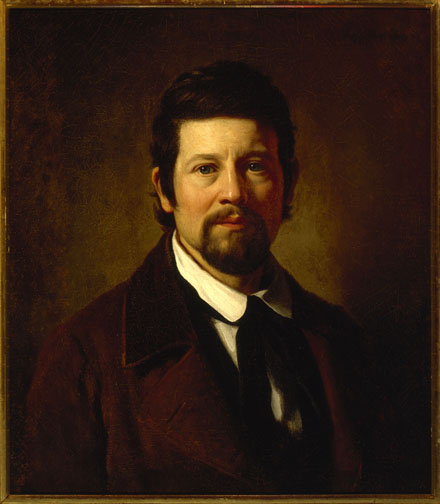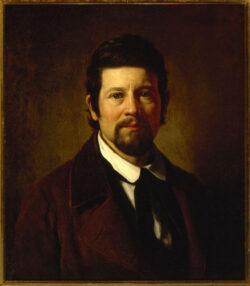Jacques Amans
French artist Jacques Amans was the leading portraitist in New Orleans during the 1840s and 1850s.

Courtesy of The Historic New Orleans Collection
Jacques Guillaume Lucien Amans”. Amans, Jacques Guillaume Lucien (Artist)
French artist Jacques Amans was the leading portraitist in New Orleans from the late 1830s through the 1850s. Like other antebellum painters, Amans was drawn to the Crescent City by the promise of prosperity and success. Like his colleague Jean-Joseph Vaudechamp, Amans followed the neoclassical style advocated by the École des Beaux Arts. Yet Amans’s style is warmer, his touch more delicate, and his characterizations less direct and arresting. His is an elegant style of painting suited to the presentation of sophisticated, wealthy patrons. Amans’s subjects ranged from the wives and daughters of New Orleans’s social elite to Andrew Jackson. He found greatest favor, however, among the owners of plantations along the Mississippi River.
Early Life and Career
In 1801, Jacques Guillaume Lucien Amans was born in the city of Maastricht. Though the city is in the Netherlands today, at the time it was part of the French Republic. According to descendant Pierre-Michel van Win, Amans considered himself to be French. He was the son of Paul-Serge Amans, born in 1765, who served as cavalry captain in the Army of the French Republic, and was elected a knight in the Legion of Honor. His mother, Thésèse Visschers, was also born in Maastricht, where the couple married in 1798. Amans had four sisters: Pauline, Sophie, Eugénie, and Elsie.
Little is known about Amans’s early training. According to Emmanuel Bénézit’s authoritative Dictionnaire, he exhibited at the Paris Salon between 1831 and 1837. Curiously, Bénézit describes him as an American portrait painter, despite Amans’s European heritage. It is likely that he studied at the École des Beaux Arts in Paris, but no definitive record of his enrollment has surfaced. He clearly trained with an academic painter and was accomplished enough to be accepted at that Salon by the time he was thirty.
Circumstantial evidence suggests that Jean Joseph Vaudechamp encouraged Amans to come to Louisiana about 1836. The two artists traveled together on the same ship in both 1836 and 1837. Each had studios in New Orleans on Royal Street, between St. Peter and Toulouse Streets, in 1837. As was common among non-native artists, Amans and Vaudechamp remained in Louisiana only during the winters. Fear of yellow fever and other diseases curtailed longer visits; winters were also when the plantation owners and merchants were, as was general practice, at their residences in New Orleans. In the summer months, Amans either returned to France or followed the plantation owners to the countryside.
Career in New Orleans
Before Amans’s arrival, Vaudechamp had achieved a reputation as the finest portrait painter in a city crowded with competitors. After 1837, the last year Vaudechamp visited, Amans assumed the mantle of first painter in the city. He competed with other French émigré artists, including Aimable-Désiré Lansot and Adolphe Rinck, both of whom were trained in the French neoclassical style and seem to have been encouraged to come to New Orleans by Vaudechamp. While Amans had no direct follower, George David Coulon was, as noted in Coulon’s brief autobiography, at least an informal student about 1840.
Amans’s elegant neoclassical style appealed especially to French émigré plantation owners. His work was lauded in newspaper such as Revue Louisianaise: “The exactness of the drawing, the firmness of contours and the animation which is characteristic of what we know of Mr. Amans suggest strongly to us that this is of the Italian school.” His portraits of women are particularly flattering, characterized by the application multiple glazes of various hues to delineate skin tones. The technique is most pronounced approaching the hairline.
Amans returned to New Orleans nearly every year between 1836 and 1856. He was immediately prosperous, as suggested by his purchase of Trinity Plantation on the Bayou Lafourche. He married Marguerite Azoline Landreaux, the daughter of a sugar planter in St. Charles Parish, in 1844. About this time, he also purchased property in Bay St. Louis, which he reportedly sold in 1852.
When Andrew Jackson returned to New Orleans on January 8, 1840, for the twenty-fifth anniversary of the Battle of New Orleans, Amans capitalized on public enthusiasm. On January 10, 1840, he wrote a letter to Jackson in English asking him to sit for a portrait, noting that he intended to present it to the citizens of “this great and growing city.” “Four sittings of an hour each will suffice for this purpose,” he concluded, and the general would not be burdened by “the necessity of interrupting your conversations with your friends and visitors.” The letter is now part of the Jackson Papers at the Library of Congress.
Jackson consented, and Amans presumably executed a full-length portrait shortly after this. The painting ended up in the hands of New Orleans mayor John T. Monroe, who sold it during the Civil War. The portrait was eventually presented to Brown University in Providence, Rhode Island, in 1866. Amans probably painted several other versions of Jackson’s portrait. In 1844, for example, he collaborated with Theodore S. Moise on an equestrian portrait of Jackson. The painting was awarded a $1,000 prize by the city council for “the best portrayal of the hero of 1815” and was hung in the city council hall. A writer in the New Orleans Bee noted that “the general effect of the portrait is striking, simple, and at the same time animated.”
In 1848, Amans again exploited the sudden demand for portraits of a political figure. The election of Zachary Taylor sparked a nearly unprecedented demand for his likeness. Amans traveled to Baton Rouge, where he faced competition from other artists eager to be granted a sitting with the general. Amans’s portrait of Taylor was eventually disposed of by lottery during the last days of 1857.
Amans maintained close ties to the Catholic community in New Orleans, painting many portraits of religious and charitable leaders, including a portrait of Margaret Haughery, the proprietress of an Irish orphanage in New Orleans. Painted about 1842, the portrait featured Haughery in front of a church steeple, gazing toward the viewer while embracing a sleeping orphan. Her countenance and gesture at once suggest vigilance and compassion. Amans also painted the Ascension of Saint Joseph about 1846 for St. Augustine Church.
In 1856, Amans trusted A. Rocherau & Co. with his American real estate and returned to France. He purchased a property near Versailles called Lacour Levy. He died in Paris in 1888.
Jessie Poesch reported about seventy-five paintings known to have been painted by Amans, about one-third of which are signed. The Louisiana State Museum, the Historic New Orleans Collection, the New Orleans Museum of Art, and the Ogden Museum include his work in their collections. Many of Amans’s portraits are also in private hands, including a handful still hanging in Louisiana plantation houses along the Mississippi River.
